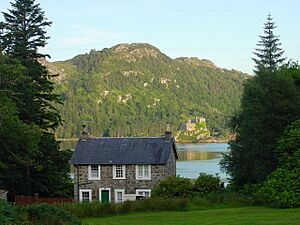Eilean Shona facts for kids
| Gaelic name | Eilean Seòna |
|---|---|
| Meaning of name | Possibly from the Norse for 'sea island' |
| OS grid reference | NM645739 |
| Coordinates | 56°47′55″N 5°51′39″W / 56.79859924°N 5.86086945°W |
| Physical geography | |
| Island group | Inner Hebrides |
| Area | 525 hectares (1,300 acres) |
| Area rank | 72 |
| Highest elevation | Beinn a' Bhàillidh, 265 metres (869 ft) |
| Administration | |
| Sovereign state | United Kingdom |
| Country | Scotland |
| Council area | Highland |
| Demographics | |
| Population | 2 |
| Population density | 0.4 people/km2 |
| Largest settlement | Invermoidart |
Eilean Shona (Scottish Gaelic: Eilean Seòna) is a special island in Scotland. It is located in Loch Moidart. The name Eilean Shona might come from an old language called Old Norse. It could mean "sea island".
Eilean Shona is known as a tidal island. This means that at certain times, when the tide is very low, you can actually walk to it from the mainland! It's one of 17 such islands in mainland Scotland.

A Special Visitor: J. M. Barrie
A very famous writer named J. M. Barrie loved Eilean Shona. He is the author who created the magical story of Peter Pan.
In the 1920s, Barrie rented the island for his summer holidays. He stayed there with his foster sons and their friends. It was on Eilean Shona that he wrote a screenplay for the 1924 Peter Pan film.
Island History
For many years, Eilean Shona was home to a number of farmers, called crofters. In the mid-1800s, a sea captain named Captain Swinburne owned the main house. He was a keen gardener. He collected many different types of pine trees from his travels. He planted them on the island, creating a unique collection of trees.
Later, a famous architect named Robert Lorimer made the main house much bigger. This happened at the end of the 1800s.
In the 1930s, the island was given as a wedding gift to Lady Howard De Walden. Her family made many improvements to the gardens and grounds.
The island has changed owners a few times since then. In 1995, Vanessa Branson and Robert Devereux bought Eilean Shona. Vanessa Branson has opened parts of the island for people to rent for holidays. This includes the large main house and several smaller cottages.
Life on the Island
Today, only a few people live on Eilean Shona all the time. The population is usually two people.
There are other small islands in Loch Moidart too. These include Riska Island and Eilean Tioram. The main house on Eilean Shona looks out over Riska Island and Castle Tioram.
There is an old schoolhouse on the island. It is in a very quiet spot, about two miles down a track. People say it was built there because the owner's wife didn't want to be bothered by children!


